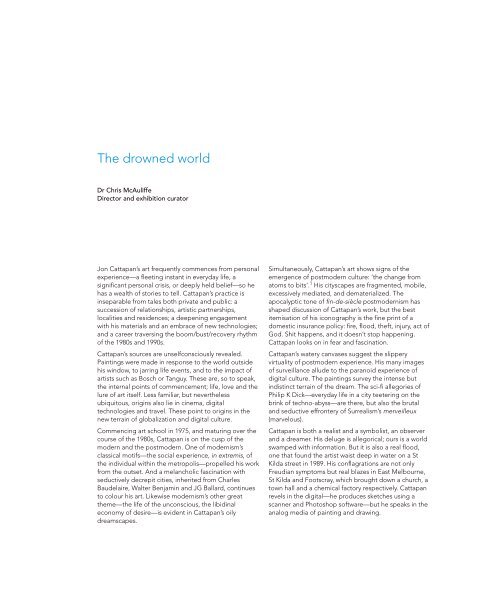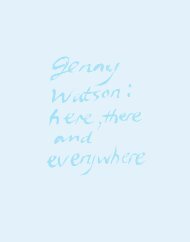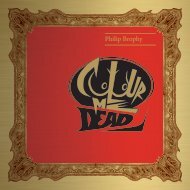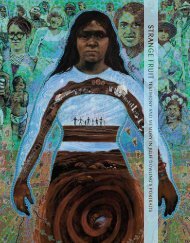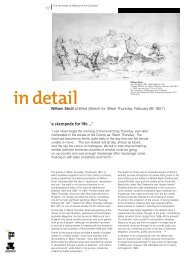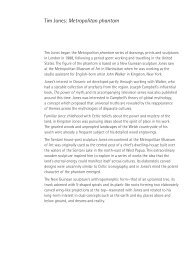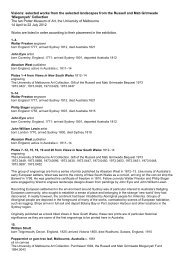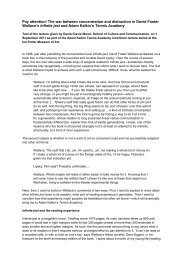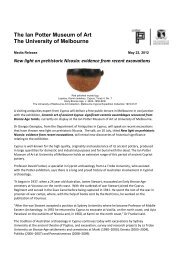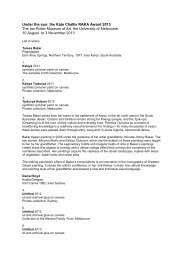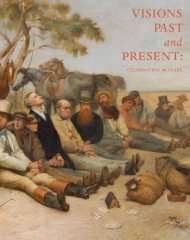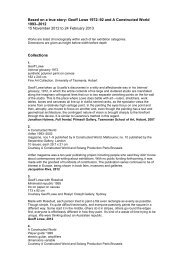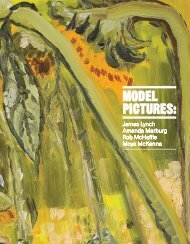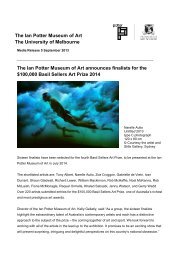The drowned world Jon Cattapan works and collaborations
Catalogue - Ian Potter Museum of Art - University of Melbourne
Catalogue - Ian Potter Museum of Art - University of Melbourne
- No tags were found...
Create successful ePaper yourself
Turn your PDF publications into a flip-book with our unique Google optimized e-Paper software.
<strong>The</strong> <strong>drowned</strong> <strong>world</strong><br />
Dr Chris McAuliffe<br />
Director <strong>and</strong> exhibition curator<br />
<strong>Jon</strong> <strong>Cattapan</strong>’s art frequently commences from personal<br />
experience—a fleeting instant in everyday life, a<br />
significant personal crisis, or deeply held belief—so he<br />
has a wealth of stories to tell. <strong>Cattapan</strong>’s practice is<br />
inseparable from tales both private <strong>and</strong> public: a<br />
succession of relationships, artistic partnerships,<br />
localities <strong>and</strong> residences; a deepening engagement<br />
with his materials <strong>and</strong> an embrace of new technologies;<br />
<strong>and</strong> a career traversing the boom/bust/recovery rhythm<br />
of the 1980s <strong>and</strong> 1990s.<br />
<strong>Cattapan</strong>’s sources are unselfconsciously revealed.<br />
Paintings were made in response to the <strong>world</strong> outside<br />
his window, to jarring life events, <strong>and</strong> to the impact of<br />
artists such as Bosch or Tanguy. <strong>The</strong>se are, so to speak,<br />
the internal points of commencement; life, love <strong>and</strong> the<br />
lure of art itself. Less familiar, but nevertheless<br />
ubiquitous, origins also lie in cinema, digital<br />
technologies <strong>and</strong> travel. <strong>The</strong>se point to origins in the<br />
new terrain of globalization <strong>and</strong> digital culture.<br />
Commencing art school in 1975, <strong>and</strong> maturing over the<br />
course of the 1980s, <strong>Cattapan</strong> is on the cusp of the<br />
modern <strong>and</strong> the postmodern. One of modernism’s<br />
classical motifs—the social experience, in extremis, of<br />
the individual within the metropolis—propelled his work<br />
from the outset. And a melancholic fascination with<br />
seductively decrepit cities, inherited from Charles<br />
Baudelaire, Walter Benjamin <strong>and</strong> JG Ballard, continues<br />
to colour his art. Likewise modernism’s other great<br />
theme—the life of the unconscious, the libidinal<br />
economy of desire—is evident in <strong>Cattapan</strong>’s oily<br />
dreamscapes.<br />
Simultaneously, <strong>Cattapan</strong>’s art shows signs of the<br />
emergence of postmodern culture: ‘the change from<br />
atoms to bits’. 1 His cityscapes are fragmented, mobile,<br />
excessively mediated, <strong>and</strong> dematerialized. <strong>The</strong><br />
apocalyptic tone of fin-de-siècle postmodernism has<br />
shaped discussion of <strong>Cattapan</strong>’s work, but the best<br />
itemisation of his iconography is the fine print of a<br />
domestic insurance policy: fire, flood, theft, injury, act of<br />
God. Shit happens, <strong>and</strong> it doesn’t stop happening.<br />
<strong>Cattapan</strong> looks on in fear <strong>and</strong> fascination.<br />
<strong>Cattapan</strong>’s watery canvases suggest the slippery<br />
virtuality of postmodern experience. His many images<br />
of surveillance allude to the paranoid experience of<br />
digital culture. <strong>The</strong> paintings survey the intense but<br />
indistinct terrain of the dream. <strong>The</strong> sci-fi allegories of<br />
Philip K Dick—everyday life in a city teetering on the<br />
brink of techno-abyss—are there, but also the brutal<br />
<strong>and</strong> seductive effrontery of Surrealism’s merveilleux<br />
(marvelous).<br />
<strong>Cattapan</strong> is both a realist <strong>and</strong> a symbolist, an observer<br />
<strong>and</strong> a dreamer. His deluge is allegorical; ours is a <strong>world</strong><br />
swamped with information. But it is also a real flood,<br />
one that found the artist waist deep in water on a St<br />
Kilda street in 1989. His conflagrations are not only<br />
Freudian symptoms but real blazes in East Melbourne,<br />
St Kilda <strong>and</strong> Footscray, which brought down a church, a<br />
town hall <strong>and</strong> a chemical factory respectively. <strong>Cattapan</strong><br />
revels in the digital—he produces sketches using a<br />
scanner <strong>and</strong> Photoshop software—but he speaks in the<br />
analog media of painting <strong>and</strong> drawing.


